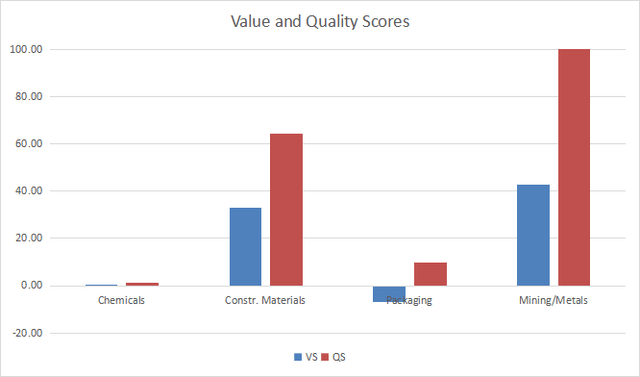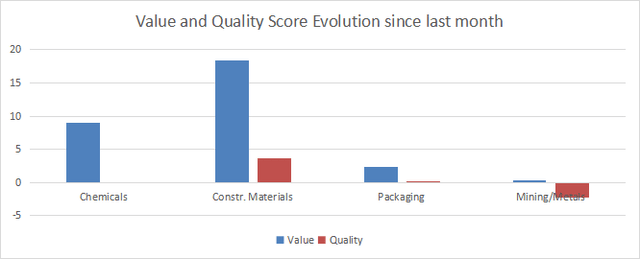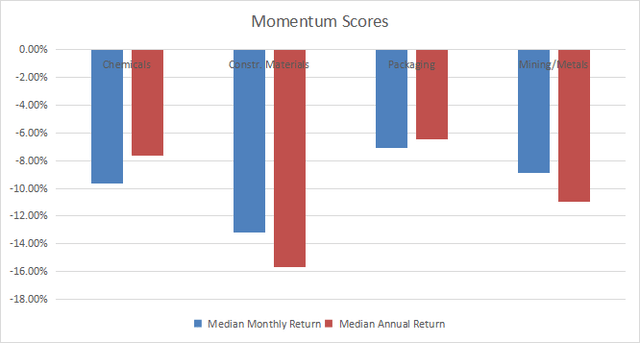Avalon_Studio
This monthly article series shows a dashboard with aggregate industry metrics in materials. It is also a review of sector ETFs like the Materials Select Sector SPDR ETF (XLB), the iShares U.S. Basic Materials ETF (IYM), and other ones whose largest holdings are used to calculate these metrics.
Shortcut
The next two paragraphs in italic describe the dashboard methodology. They are necessary for new readers to understand the metrics. If you are used to this series or if you are short of time, you can skip them and go to the charts.
Base Metrics
I calculate the median value of five fundamental ratios for each industry: Earnings Yield (“EY”), Sales Yield (“SY”), Free Cash Flow Yield (“FY”), Return on Equity (“ROE”), Gross Margin (“GM”). The reference universe includes large companies in the U.S. stock market. The five base metrics are calculated on trailing 12 months. For all of them, higher is better. EY, SY and FY are medians of the inverse of Price/Earnings, Price/Sales and Price/Free Cash Flow. They are better for statistical studies than price-to-something ratios, which are unusable or non available when the “something” is close to zero or negative (for example, companies with negative earnings). I also look at two momentum metrics for each group: the median monthly return (RetM) and the median annual return (RetY).
I prefer medians to averages because a median splits a set in a good half and a bad half. A capital-weighted average is skewed by extreme values and the largest companies. My metrics are designed for stock-picking rather than index investing.
Value and Quality Scores
I calculate historical baselines for all metrics. They are noted respectively EYh, SYh, FYh, ROEh, GMh, and they are calculated as the averages on a look-back period of 11 years. For example, the value of EYh for packaging in the table below is the 11-year average of the median Earnings Yield in packaging companies.
The Value Score (“VS”) is defined as the average difference in % between the three valuation ratios (EY, SY, FY) and their baselines (EYh, SYh, FYh). The same way, the Quality Score (“QS”) is the average difference between the two quality ratios (ROE, GM) and their baselines (ROEh, GMh).
The scores are in percentage points. VS may be interpreted as the percentage of undervaluation or overvaluation relative to the baseline (positive is good, negative is bad). This interpretation must be taken with caution: the baseline is an arbitrary reference, not a supposed fair value. The formula assumes that the three valuation metrics are of equal importance.
Current data
The next table shows the metrics and scores as of last week’s closing. Columns stand for all the data named and defined above.
|
VS |
QS |
EY |
SY |
FY |
ROE |
GM |
EYh |
SYh |
FYh |
ROEh |
GMh |
RetM |
RetY |
|
|
Chemicals |
0.02 |
1.24 |
0.0531 |
0.4834 |
0.0162 |
19.46 |
40.14 |
0.0438 |
0.4581 |
0.0221 |
17.94 |
42.68 |
-9.65% |
-7.62% |
|
Constr. Materials |
33.14 |
64.54 |
0.0559 |
1.0429 |
0.0313 |
22.98 |
30.17 |
0.0295 |
0.8973 |
0.0334 |
10.27 |
28.68 |
-13.21% |
-15.67% |
|
Packaging |
-6.96 |
9.91 |
0.0658 |
1.0410 |
0.0159 |
21.95 |
23.99 |
0.0478 |
1.0581 |
0.0369 |
17.64 |
25.16 |
-7.09% |
-6.48% |
|
Mining/Metals |
42.93 |
100* |
0.0997 |
1.3938 |
0.0148 |
25.24 |
25.06 |
0.0411 |
1.1720 |
0.0220 |
8.74 |
20.61 |
-8.91% |
-10.96% |
* capped for convenience
Value and Quality chart
The next chart plots the Value and Quality Scores by industry (higher is better).
Value and quality in materials (Chart: author; data: Portfolio123)
Evolution since last month
The value score has significantly improved in chemicals and construction materials.
Score variations (Chart: author; data: Portfolio123)
Momentum
The next chart plots momentum data.
Momentum in Materials (Chart: author; data: Portfolio123)
Interpretation
Mining/metals and construction materials are undervalued relative to 11-year averages, by about 43% and 33% respectively. Both sectors also have excellent quality scores. Chemicals are very close to the historical baseline in both value and quality. Packaging is slightly overvalued, but this may be justified by a good quality score.
Fast facts on MXI
The iShares Global Materials ETF (NYSEARCA:MXI) has been tracking the S&P Global 1200 Materials Index since 9/12/2006. It has a dividend yield of 5.62% and a total expense ratio of 0.40% (vs. 0.10% for XLB).
The fund holds 138 stocks and it is quite concentrated: the top 10 companies weigh 33.3% of asset value and each of the top 2 names is over 6%. However, it is more diversified than XLB, which has 61.3% in the top 10 holdings and 16.8% in the largest one. The next table shows MXI top 10 names with some fundamental ratios.
|
Name |
U.S. ticker |
Holding ticker |
Country |
Weight% |
EPS growth %TTM |
P/E TTM |
P/E fwd |
Yield% |
|
Linde Plc |
LIN |
US |
6.62 |
10.59 |
41.38 |
23.89 |
1.64 |
|
|
BHP Group Ltd. |
BHP |
Australia |
6.13 |
N/A |
4.25 |
8.28 |
12.46 |
|
|
L’Air Liquide SA |
AI |
France |
2.99 |
8.87 |
N/A |
20.80 |
2.22 |
|
|
Glencore Plc |
GLEN |
UK |
2.86 |
714.25 |
4.78 |
7.81 |
6.44 |
|
|
Rio Tinto |
RIO |
UK |
2.74 |
-4.77 |
5.16 |
5.93 |
13.16 |
|
|
Air Products and Chemicals, Inc. |
APD |
US |
2.61 |
14.04 |
25.54 |
24.88 |
2.53 |
|
|
The Sherwin-Williams Co. |
SHW |
US |
2.6 |
-16.44 |
34.64 |
26.72 |
1.04 |
|
|
Vale SA |
VALE |
Brazil |
2.4 |
23.74 |
3.21 |
3.67 |
22.19 |
|
|
Nutrien Ltd. |
NTR |
Canada |
2.24 |
633.78 |
7.23 |
5.31 |
2.14 |
|
|
Anglo American PLC |
AAL |
UK |
2.09 |
6.01 |
5.82 |
5.88 |
7.18 |
Ratios from Portfolio123
MXI has underperformed XLB since inception by about 3 percentage points in annualized return (see next table). Moreover, it shows a much higher risk in drawdown and volatility (standard deviation of monthly returns).
|
Total return |
Annualized return |
Max Drawdown |
Sharpe ratio |
Volatility |
|
|
MXI |
117.30% |
4.97% |
-66.67% |
0.28 |
23.25% |
|
XLB |
242.09% |
8.00% |
-59.66% |
0.43 |
21.03% |
Data calculated with Portfolio123
In summary, MXI is a fund for investors seeking diversified and global exposure in basic materials. It currently holds 138 global stocks including large and mid-caps, whereas XLB invests in 29 large U.S. companies. However, past performance is underwhelming. Investors who are concerned by risks related to the top holding weight in capital-weighted ETFs may prefer the Invesco S&P 500 Equal Weight Materials ETF (RTM).
Dashboard List
I use the first table to calculate value and quality scores. It may also be used in a stock-picking process to check how companies stand among their peers. For example, the EY column tells us that a chemical company with an Earnings Yield above 0.0531 (or price/earnings below 18.83) is in the better half of the industry regarding this metric. A Dashboard List is sent every month to Quantitative Risk & Value subscribers with the most profitable companies standing in the better half among their peers regarding the three valuation metrics at the same time. The list below was sent to subscribers several weeks ago based on data available at this time.
|
United States Steel Corp. |
|
|
Cleveland-Cliffs, Inc. |
|
|
Olin Corp. |
|
|
Veritiv Corp. |
|
|
The Chemours Co. |
|
|
O-I Glass, Inc. |
|
|
LyondellBasell Industries NV |
It is a dynamic, monthly list with a statistical bias toward excess returns on the long-term, not the result of an analysis of each stock.


Be the first to comment